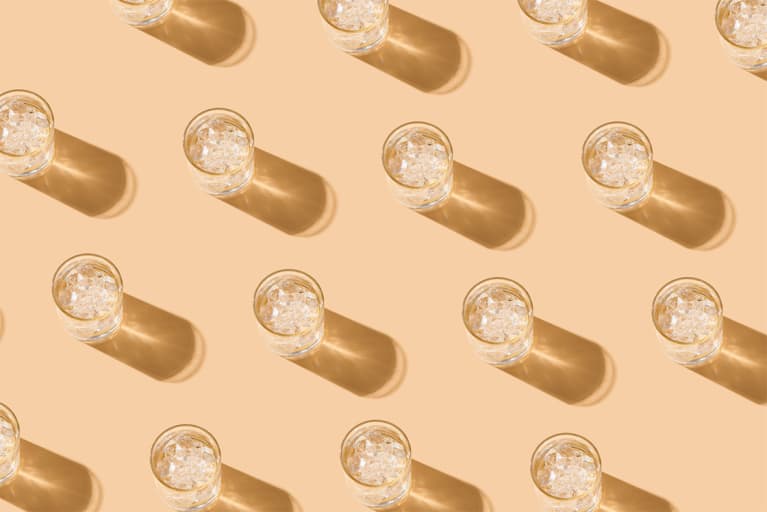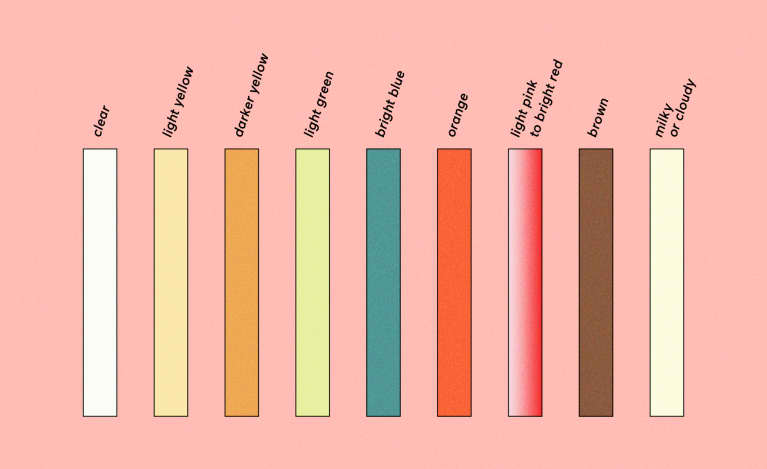What Color Is My Pee Supposed to Be
What Your Urine Is Telling You About Your Health + A Pee Color Chart

Urine health may not always be top of mind, but when something changes (color, smell, consistency), in your normal pee patterns, it can be concerning. While getting a urine sample or talking to a doctor is a good idea, there are a few things to keep in mind about what different color urine might be signaling. Let's talk pee:
Your pee color chart and what it means.
Urine color can range from clear to brown (see chart below for the full spectrum). While some of these hues may seem a bit, well, alarming, experts share exactly what each of these pee colors means about your health.

Clear
If you thought clear urine was a sign of good health, you're not alone. A lot of people think the more water, the better—but that's not necessarily true.
What it means: Clear pee is one of the first indicators of overhydration. The body is attempting to get rid of the excess water you've ingested, urologist Vannita Simma-Chiang, M.D., tells mbg.
What to do: Stop drinking until you're thirsty again and pee returns to a normal, light yellow.
Light yellow
What it means: A light yellow urine is completely normal, Simma-Chiang says. This is the optimal urine color to maintain.
What to do: Whatever you've been doing, because it's working. (Here: A pee health routine to follow.)
Dark yellow
What it means: Dark yellow urine is common in the morning when more than eight hours have passed since your last drink of water. It can also happen throughout the day, though, if you've gone too long without hydrating. Simply put, Simma-Chiang says, "It probably means you're slightly dehydrated."
What to do: Drink some water, and consider limiting dehydrating food and drinks.
Orange
What it means: Certain urinary tract infection (UTI) medications or multivitamins, like B12 and C, can lead to an orange-hued pee, Simma-Chiang says.
What to do: Be aware of the vitamins and medications you're taking, and ask your doctor if you're concerned about the color.
Green
What it means: Similar to orange urine, green urine may be a side effect of certain vitamins. It could also be caused by green food dye. "That's a slight, light green," Simma-Chiang says. "It shouldn't be bright."
What to do: Take note of the vitamins or food you've consumed. If the color persists or seems alarming, consult with a doctor.
Blue
What it means: If you've visited a urologist or had a procedure done recently, you may have been given a medication called methylene blue, which will turn the urine a bright blue color, she explains. Certain blue-dyed foods can also be the cause.
What to do: This should pass when you stop taking the medication or pee out the rest of the food dye. Call your doctor with any concerns.
Light pink to red
What it means: Unless you've eaten beets recently, red or pink urine could indicate blood. "If your urine is red or has a thick blood-like consistency, that's absolutely abnormal," she tells mbg.
Light pink can also be an indicator of kidney stones or bleeding in the urinary tract. If you're menstruating, it could just be menstrual blood mixing with the urine, not the urine itself.
What to do: Anything bright red is alarming, so Simma-Chiang urges calling a physician or urologist to get it examined. If you're unsure whether or not it's menstrual blood, call a gynecologist.
Brown
What it means: There might be a fistula (aka an abnormal connection) between the urinary tract and the rectum or the bowels, Simma-Chiang says. It may also indicate blood in the urine, liver disease, kidney disease, or an infection.
What to do: Call a doctor or urologist to get this examined.
When to seek medical help:
"Don't be afraid to bring your questions to your doctor," biophysicist Ajay Goel, Ph.D., previously told mbg. "Remember, your doctor has seen and heard everything, so don't hold back when you need to discuss your concerns."
If you think a new supplement or medication may be to blame for your strange pee color, stop taking it (under your doctor's guidance) and track the pee to see if anything changes.
If you're not taking anything new but are noticing abnormal changes to your urine, talking to a doctor or getting a urine sample tested is the safest bet. Especially if urine is red, pink, brown, or has a strange smell and consistency.
Other FAQs about pee color:
What about the consistency?
"An occasional milky or cloudy appearance of urine can be normal—especially in the morning when you may be slightly dehydrated," Goel says. If it's persistent, though, it might be a sign of a urinary tract infection. While there's mixed research about whether or not cloudy urine is a sign of a UTI, seeing a doctor or a urologist to rule out bacterial infections is a good idea. "If you have a history of stone disease, crystals may also appear in urine, making it cloudy," Simma-Chiang adds.
What about the smell?
So your urine is smelling...um, different...and you haven't had any asparagus? "That could be medication changes, or if you ate something unusual," Simma-Chiang says. Other foods that commonly cause a change in urine smell are fish, onion, garlic, and coffee, to name a few. Strong-smelling pee might also be a sign of yeast infection, candida overgrowth, or urinary tract infection (UTI).
How often should you be peeing?
In general, the average, healthy person will pee between three and four times per day, Simma-Chiang tells mbg. Of course that can vary based on age, medications, what and how often someone's drinking, and more factors. If you're peeing any less than that, you may need to drink more water. Peeing any more, and you may need to lower your water consumption—or consider speaking with a doctor, to rule out diabetes as a potential cause.
The bottom line.
Urine color can range from clear to dark brown, and the healthiest color for pee is a light yellow. While some abnormal colors may not be of any concern but rather a side effect of supplements and medications, it's always safe to call your doctor and rule out potentially concerning causes.
You are now subscribed
Be on the lookout for a welcome email in your inbox!
A Modern Approach to Ayurveda
With Sahara Rose

More Health
Popular Stories
https://www.mindbodygreen.com/articles/pee-color-chart
In order to save this article, you will need to Log In or Sign Up!
Close
What Color Is My Pee Supposed to Be
Source: https://www.mindbodygreen.com/articles/pee-color-chart